How to create a body recomposition workout plan to burn fat and build muscle simultaneously.
Starting a body recomposition workout plan means pursuing two goals at once: losing fat and building lean muscle. Unlike traditional programs that focus solely on weight loss or hypertrophy, a recomposition strategy balances resistance training, cardiovascular work, nutrition, and recovery to reshape your physique efficiently. In this guide, we’ll unpack the science behind body recomposition, share key principles, and provide an actionable template so you can craft your own plan and see results in as little as 8–12 weeks.
Table of Contents
1. Understanding Body Recomposition

Body recomposition refers to the process of simultaneously reducing fat mass and increasing muscle mass. Key concepts include:
- Energy Balance & Metabolic Adaptation: Achieving a slight caloric deficit (~250 kcal/day) while ensuring sufficient protein intake to fuel muscle protein synthesis.
- Concurrent Training: Blending strength training and cardio in the same program to optimize both hypertrophy and fat oxidation.
- Hormonal Environment: Managing insulin, cortisol, and testosterone levels through meal timing, stress management, and sleep.
“Recomposition isn’t about drastic cuts or massive bulks—it’s about precision, patience, and progressive overload.”
—Dr. Laura Metz, Exercise Physiologist
2. Key Principles of an Effective Body Recomposition Workout Plan
An optimized recomposition routine hinges on these core pillars:
- Progressive Overload
- Increase weight, reps, or training density over time.
- Aim for a 2–5% increase in load every 1–2 weeks.
- Training Frequency & Volume
- Target each muscle group 3× per week for strength and hypertrophy stimuli.
- Total 10–15 sets per muscle group per week balances growth and recovery.
- Training Modalities
- Resistance Training: Compound lifts (squat, deadlift, bench) + isolation movements (leg curl, triceps extension).
- Cardiovascular Work: Two to three weekly sessions of moderate‑intensity cardio (30–45 minutes) and 1–2 HIIT workouts (15–20 minutes).
- Intensity & Effort (RPE)
- Strength days: 4–6 reps @ 80–85% 1RM (RPE 8–9)
- Hypertrophy days: 8–12 reps @ 65–75% 1RM (RPE 7–8)
- Recovery & Adaptation
- Rest between sets: 60–120 seconds for hypertrophy; 2–3 minutes for strength lifts.
- Sleep: 7–9 hours nightly to support muscle repair and hormonal balance.
3. Designing Your Weekly Body Recomposition Workout Plan
Below is a sample 4‑day split that integrates strength, hypertrophy, and cardio for a balanced body recomposition program:
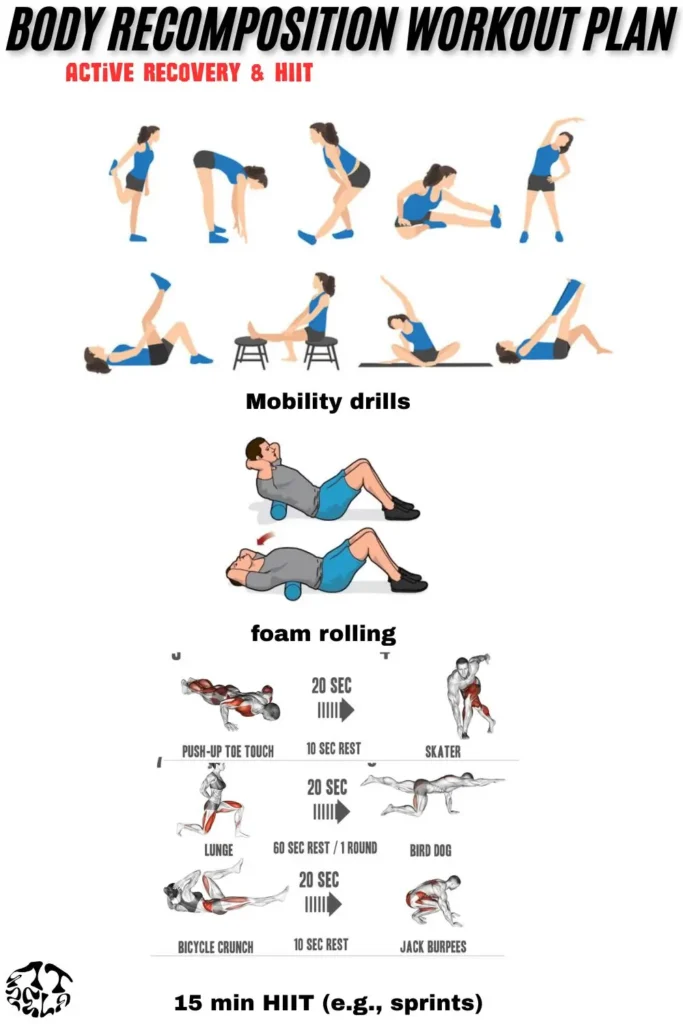

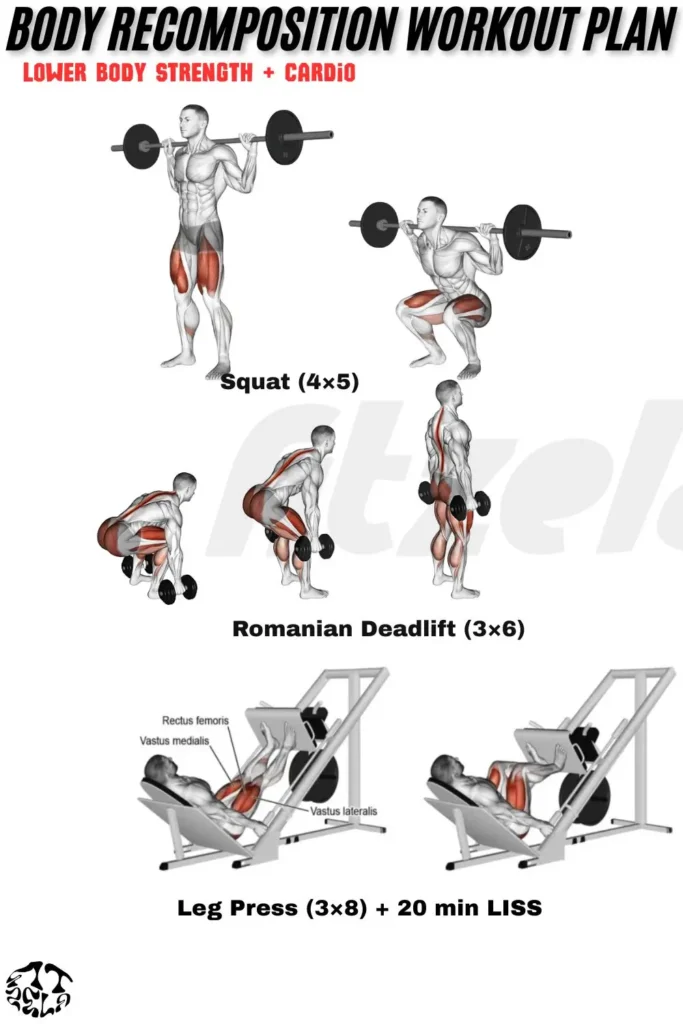
| Day | Focus | Exercises (Sets × Reps) |
|---|---|---|
| Day 1 | Lower Body Strength + Cardio | Squat (4×5), Romanian Deadlift (3×6), Leg Press (3×8) + 20 min LISS |
| Day 2 | Upper Body Hypertrophy | Bench Press (3×10), Pull‑Up (3×8), Dumbbell Row (3×12), Bicep Curl (2×15) |
| Day 3 | Active Recovery & HIIT | Mobility drills, foam rolling + 15 min HIIT (e.g., sprints) |
| Day 4 | Full‑Body Strength | Deadlift (3×5), Overhead Press (3×6), Front Squat (3×8) |
| Day 5 | Full‑Body Hypertrophy + Cardio | Incline Press (3×12), Seated Row (3×12), Lateral Raise (3×15) + 30 min LISS |
| Days 6–7 | Rest & Mobility | Yoga, stretching, light swim or walk |
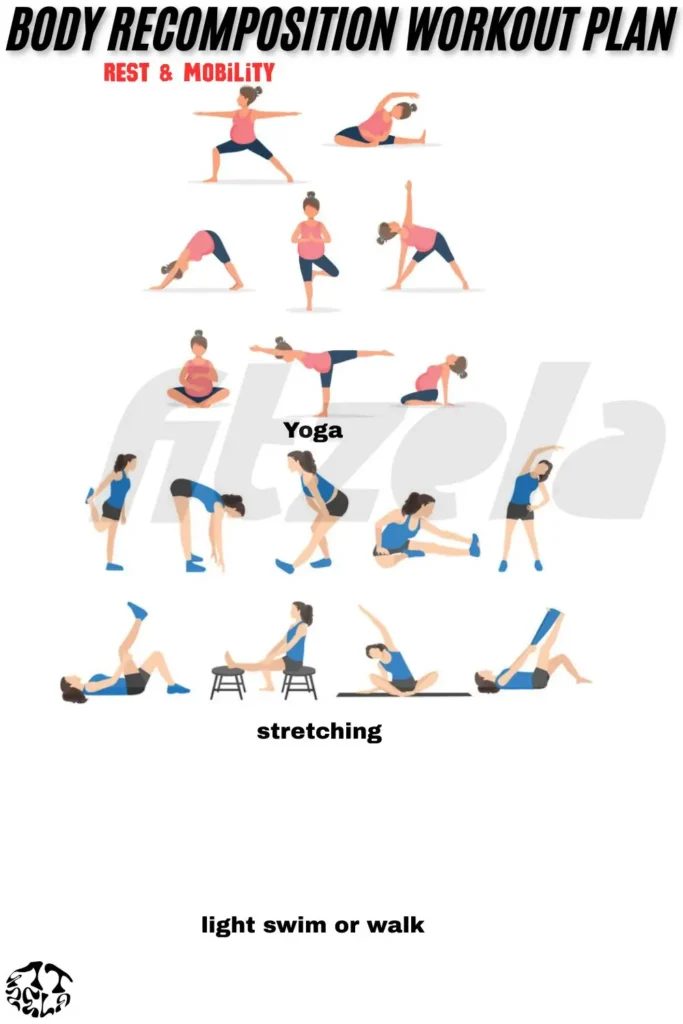
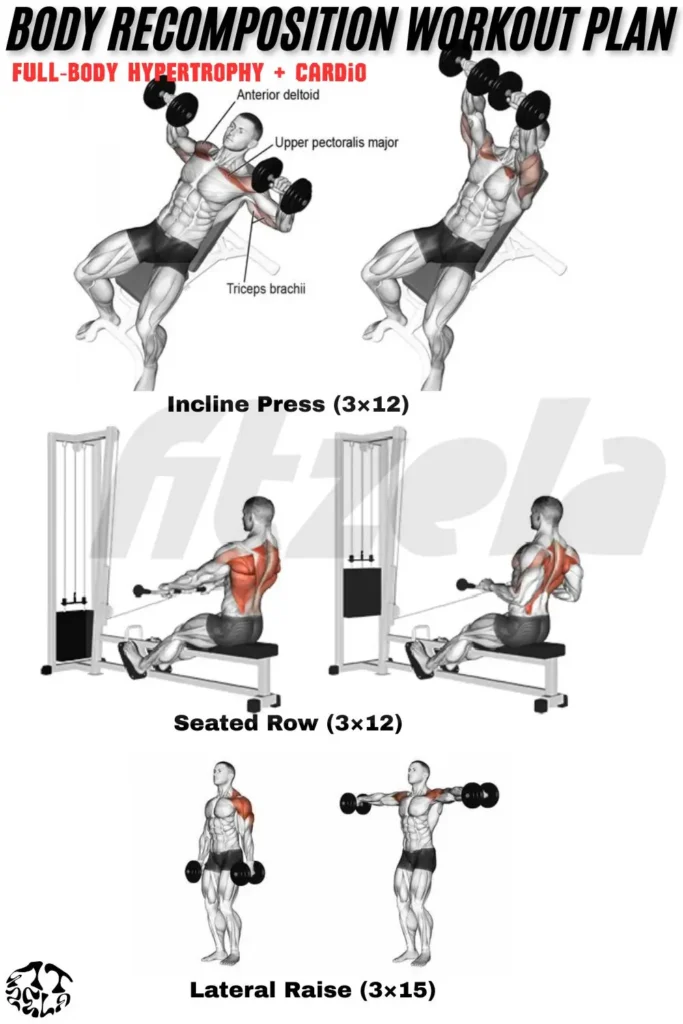
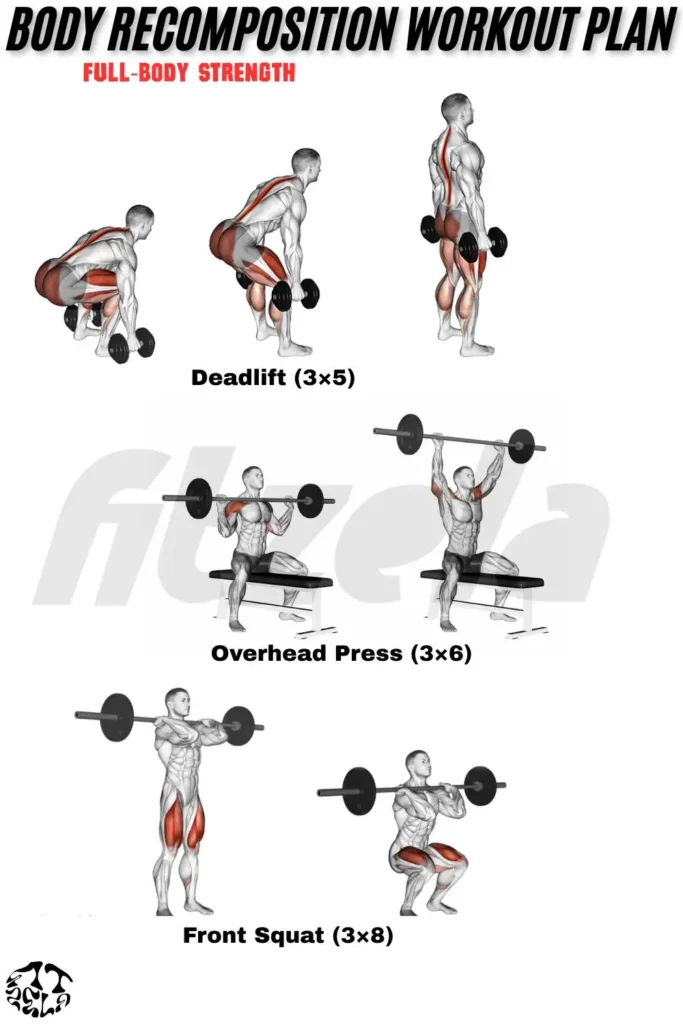
Pro Tip: Schedule strength sessions on non‑consecutive days to maximize neural recovery and maintain high training intensity.
4. Nutrition & Recovery for Simultaneous Fat Loss and Muscle Gain
Nutrition is the linchpin of any body recomposition workout plan:
- Protein Intake: Aim for 1.8–2.2 g/kg of body weight daily to support muscle synthesis.
- Caloric Strategy: Maintain a mild deficit (≈250 kcal below maintenance) to encourage fat loss without compromising muscle growth.
- Macronutrient Split:
- Protein: 30–35% of calories
- Carbohydrates: 40–45% (prioritize around workouts)
- Fats: 20–25% (focus on omega‑3 sources)
Recovery Tactics:
- Sleep hygiene: Consistent bedtime, screen‑free wind‑down, and cool room temperature.
- Active recovery: Contrast baths, foam rolling, and yoga to reduce soreness.
- Supplemental support: Creatine monohydrate, whey protein, and a multivitamin as needed.
Data Insight: A 2022 meta‑analysis found that combining resistance training with a ~10% caloric deficit preserved lean mass 30% better than deficit alone.
5. Tracking Progress & Adjusting Your Plan
Monitoring your journey ensures steady recomposition:
- Weekly Metrics
- Bodyweight and body‑fat percentage (if possible)
- Circumference measurements (waist, hips, arms, chest)
- Performance Logs
- Record loads, sets, and reps in a training journal or app.
- Note Rate of Perceived Exertion (RPE) each session.
- Visual Evidence
- Take progress photos bi‑weekly.
- Compare lighting and posture for consistency.
- Adjustment Guidelines
- If fat loss stalls for >3 weeks, lower calories by 100–150 kcal/day or add 10 minutes of cardio.
- If strength gains plateau, increase weekly volume by 5–10% or incorporate an extra set per muscle group.
Interactive Element: Try our Free Recomposition Progress Tracker to visualize your body‑fat vs. lean‑mass changes over time.

6. Common Pitfalls and How to Avoid Them
Even the best plans can go awry without attention to detail:
- Excessive Caloric Deficit
- Overcutting leads to muscle loss and hormonal imbalances. Stick to ≤10% below maintenance.
- Overtraining Syndrome
- Two-a-day workouts or constant high intensity can spike cortisol and stall progress. Include at least 1 full rest day.
- Poor Macronutrient Timing
- Neglecting carbs around workouts can leave you drained. Aim for 0.8 g/kg carbs pre- and post‑session.
- Neglecting Mobility
- Ignoring flexibility work increases injury risk. Integrate 10–15 minutes of mobility at least 3× weekly.
- Inconsistent Tracking
- Skipping measurements or logs makes adjustments guesswork. Commit to weekly check‑ins.
7. Personalizing Your Body Recomposition Workout Plan
Everyone’s journey is unique. Use this table to customize your approach:
| Profile | Training Focus | Nutrition Tweaks | Recovery Strategies |
|---|---|---|---|
| Beginner | Emphasize form and neural adaptation (2–3 days/week) | Simplified macros (40/30/30) | 8–9 hours sleep, gentle yoga |
| Intermediate | Increase volume (3–4 days/week), add supersets | Carb cycling around workouts | Contrast showers, foam roll |
| Advanced | Periodized cycles (strength → hypertrophy phases) | Precision macros + refeeds | Sauna sessions, massage |
Personal Recommendation: If you’re time‑crunched, combine compound supersets (e.g., squat → pull‑up) to save time while maintaining volume.
Conclusion & Next Steps
Crafting a body recomposition workout plan requires harmonizing training intensity, nutritional precision, and recovery tactics. By following the principles outlined—progressive overload, balanced macros, strategic cardio, and diligent tracking—you’ll be on the fast track to lean, muscular results.








